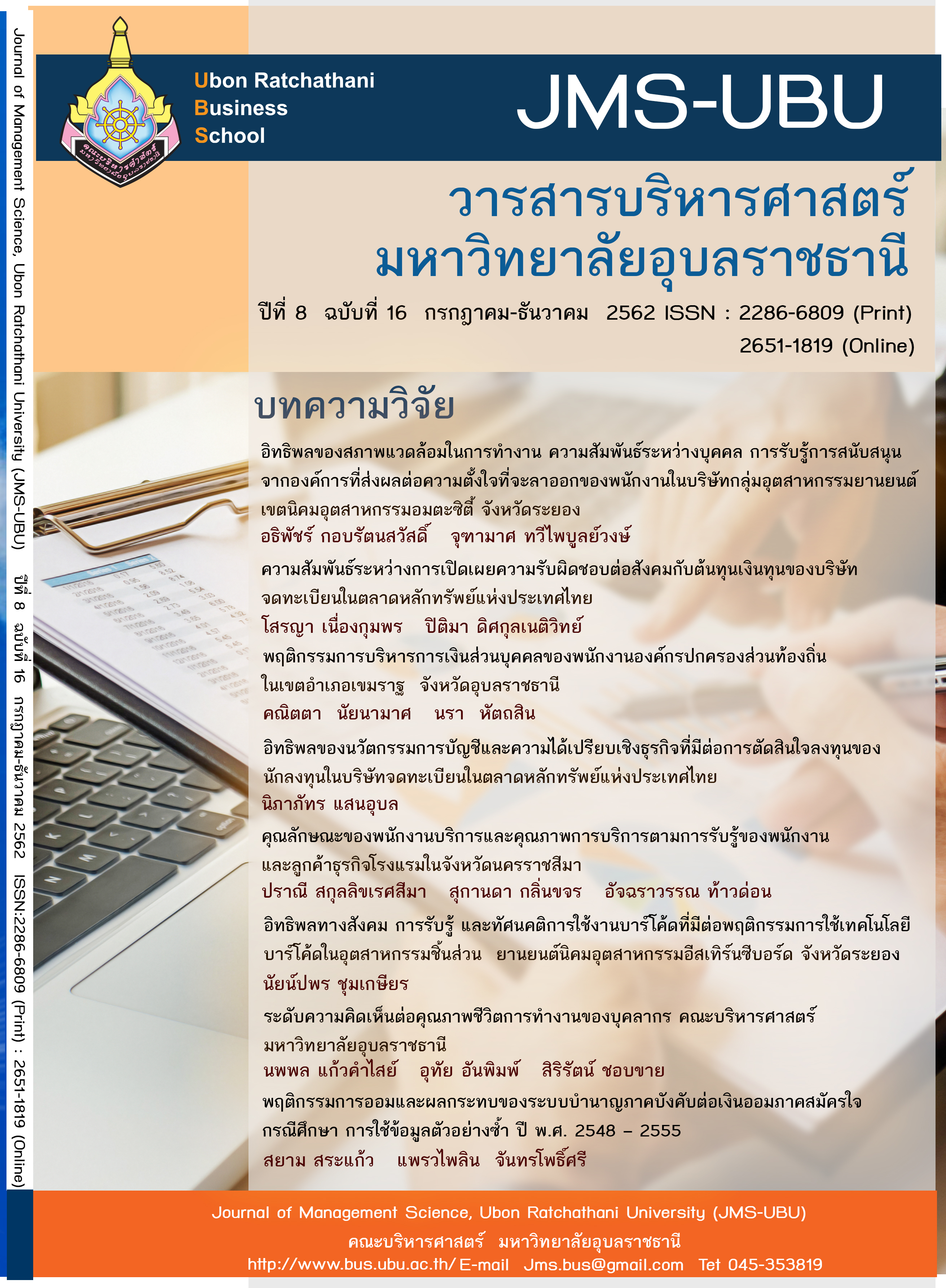พฤติกรรมการออมและผลกระทบของระบบบำนาญภาคบังคับต่อเงินออมภาคสมัครใจ กรณีศึกษา การใช้ข้อมูลตัวอย่างซ้ำ ปี พ.ศ. 2548 – 2555
Main Article Content
บทคัดย่อ
การมีระบบบำนาญภาคบังคับแสดงถึงหลักประกันรายได้ของแรงงานในอนาคตซึ่งอาจมีผลต่อแรงจูงใจในการออมภาคสมัครใจที่ลดลง งานศึกษานี้จึงมีวัตถุประสงค์หลักเพื่อศึกษาแรงจูงใจในการออมเงินส่วนบุคคลของผู้ออมเงินที่อยู่ในระบบบำนาญภาคบังคับและผู้ออมเงินที่อยู่นอกระบบบำนาญภาคบังคับ โดยใช้สถานภาพการทำงานเป็นเกณฑ์การจำแนกลักษณะผู้ออมเงิน งานศึกษานี้ใช้ข้อมูลจากโครงการสำรวจเพื่อติดตามภาวะเศรษฐกิจและสังคมของครัวเรือน (ใช้ตัวอย่างซ้ำ) ปี 2548 – 2555 การวิเคราะห์ได้ใช้แบบจำลอง Random-Effects Tobit Regression ในการประมาณค่าหาความสัมพันธ์ ผลการศึกษาพบว่า ปัจจัยที่กำหนดพฤติกรรมการออมค่อนข้างสอดคล้องกับงานศึกษาในอดีต แต่ผลการศึกษาที่ค้นพบเพิ่มเติมคือ ผู้ออมเงินนอกระบบบำนาญภาคบังคับมีแรงจูงใจในการออมเงินสูงกว่าผู้ออมเงินในระบบบำนาญภาคบังคับ โดยผลการศึกษาพบว่าผู้ออมเงินนอกระบบบำนาญภาคบังคับจะออมเงินมากในกลุ่มนายจ้าง เมื่อพิจารณาประเด็นการเปลี่ยนแปลงสถานภาพการทำงาน (FIIF)พบว่าส่งผลให้เงินออมลดลง เมื่อเทียบกับกลุ่มผู้ออมเงินที่ไม่เคยเปลี่ยนแปลงสถานภาพการทำงาน (F,I)โดยเฉพาะ ผู้ออมเงินที่ไม่เคยเปลี่ยนแปลงสถานภาพการทำงานเลยโดยอยู่นอกระบบบำนาญภาคบังคับต่อเนื่องนาน 8 ปี (I) จะออมมากกว่าผู้ออมเงินที่อยู่นอกระบบบำนาญภาคบังคับที่เคยเปลี่ยนแปลงสถานภาพการทำงาน นอกจากนี้หากพิจารณาเป็นรายสถานภาพการทำงานพบว่า ผู้ที่ประกอบธุรกิจส่วนตัว ผู้ที่ทำธุรกิจกับครอบครัวและผู้ออมเงินที่เป็นพนักงานเอกชน เป็นกลุ่มคนที่น่ากังวลว่าจะมีเงินออมไม่เพียงพอในอนาคตอันเนื่องมาจากความไม่แน่นอนของรายได้และสวัสดิการสังคมที่แตกต่างกัน ซึ่งแสดงให้เห็นว่า การมีแหล่งรายได้ทีแน่นอนและการมีสวัสดิการที่มีความเท่าเทียมกันระหว่างผู้ออมที่อยู่ในระบบและนอกระบบจะช่วยส่งเสริมให้มีการออมที่เพิ่มขึ้นได้
Downloads
Article Details

อนุญาตภายใต้เงื่อนไข Creative Commons Attribution-NonCommercial-NoDerivatives 4.0 International License.
เอกสารอ้างอิง
บุญเลิศ เลียวประไพ. (2557). ประชากรไทย อดีต-ปัจจุบัน-อนาคต. นครปฐม: สถาบันวิจัยประชากรและสังคม มหาวิทยาลัยมหิดล.
สำนักงบประมาณ. (2561). งบประมาณพอสังเขป ฉบับปรับปรุง ตามพระราชบัญญัติงบประมาณรายจ่ายประจำปีงบประมาณ พ.ศ. 2561. กรุงเทพฯ: สำนักงบประมาณ สำนักนายกรัฐมนตรี.
สำนักงานประกันสังคม. (2562). ข้อมูลสถิติกองทุนประกันสังคม. ค้นวันที่ 12 พฤษภาคม 2562, จาก https://www.sso.go.th/wpr/main/privilege/%E0%B8%82%E0%B9%89%E0%B8%AD%E0%B8%A1%E0%B8%B9%E0%B8%A5%E0%B8%AA%E0%B8%96%E0%B8%B4%E0%B8%95%E0%B8%B4%E0%B8%81%E0%B8%AD%E0%B8%87%E0%B8%97%E0%B8%B8%E0%B8%99%E0%B8%9B%E0%B8%A3%E0%B8%B0%E0%B8%81%E0%B8%B1%E0%B8%99%E0%B8%AA%E0%B8%B1%E0%B8%87%E0%B8%84%E0%B8%A1_sub_category_list-label_1_168_736
สำนักงานสถิติแห่งชาติ. (2555). การสำรวจแรงงานนอกระบบ พ.ศ. 2555 The Informal Employment Survey 2012. กรุงเทพฯ: สำนักงานสถิติแห่งชาติ.
สำนักงานสถิติแห่งชาติ. (2557). การสำรวจประชากรสูงอายุในประเทศไทย พ.ศ. 2557 The 2014 Survey of The Older Persons in Thailand. กรุงเทพฯ: สำนักงานสถิติแห่งชาติ.
สำนักงานสถิติแห่งชาติ. (2560). การสํารวจภาวะเศรษฐกิจและสังคมของครัวเรือน พ.ศ. 2560 ทั่วราชอาณาจักร The 2017 Household Socio-economic Survey Whole Kingdom. กรุงเทพฯ: สำนักงานสถิติแห่งชาติ.
สำนักงานสภาพัฒนาการเศรษฐกิจและสังคมแห่งชาติ. (2556). การคาดประมาณประชากรของประเทศไทย พ.ศ. 2553-2583 = Population Projections for Thailand 2010-2040. กรุงเทพฯ: สำนักงานคณะกรรมการพัฒนาการเศรษฐกิจและสังคมแห่งชาติ.
สุปาณี จันทรมาศ และ นวพร วิริยานุพงศ์. (ม.ป.ป.). ระบบบำเหน็จบำนาญของไทย. สำนักงานเศรษฐกิจการคลัง. ค้นวันที่ 12 พฤษภาคม 2562, จาก http://www2.fpo.go.th/S-I/Source/Article/Article146.pdf
Alessie, R., Angelini, V., & Santen, P. V. (2013). Pension Wealth and Household Savings in Europe: Evidence from SHARELIFE. European Economic Review, 63, 308-328.
Beckmann, E., Hake, M., & Urvová, J. (2013). Determinants of Households’ Savings in Central, Eastern and Southeastern Europe. Focus on European Economic Integration, 3, 8-29.
Garbero, N., Amendolaggine, J., Gasparini, L., & Bebczuk, R. N. (2015). Understanding the Determinants of Household Saving: Micro Evidence for Latin America. Inter-American Development Bank.
Chen, C. L., Kuan, C. M., & Lin, C. C. (2007). Saving and housing of Taiwanese households: New evidence from quantile regression analyses. Journal of Housing Economics, 16(2), 102-126.
Creedy, J., Gemmell, N., & Scobie, G. (2015). Pensions, savings and housing: A life-cycle framework with policy simulations. Economic Modelling, 46, 346-357.
Curley, J., Ssewamala, F., & Sherraden, M. (2009). Institutions and savings in low-income households. J. Soc. & Soc. Welfare, 36, 9.
Feldstein, M. (1974). Social security, induced retirement, and aggregate capital accumulation. Journal of political economy, 82(5), 905-926.
Feng, J., He, L., & Sato, H. (2011). Public pension and household saving: Evidence from urban China. Journal of Comparative Economics, 39(4), 470-485.
Freitas, N., E., M., & Martins, J, O. (2014). Health Pension Benefits and Longevity: How They affect household Saving?. The Journal of the Economics of Ageing, 3, 21-28.
Horioka, C. Y. (1990). Why is Japan's household saving rate so high? A literature survey. Journal of the Japanese and International Economies, 4(1), 49-92.
Lee, J. J., & Sawada, Y. (2010). Precautionary saving under liquidity constraints: Evidence from rural Pakistan. Journal of Development Economics, 91(1), 77-86.
Lusardi, A. (2008). Household saving behavior: The role of financial literacy, information, and financial education programs (NBER Working Paper 13824).Cambridge, MA: National Bureau of Economic Research. Retrieved from https://www.nber.org/papers/w13824
Lusardi, A., & Mitchel, O. (2007). Financial literacy and Retirement Preparedness: Evidence and Implications for Financial Education Programs. NBER Working Paper Series.
Mody, A., Ohnsorge, F., & Sandri, D. (2012). Precautionary savings in the Great Recession. IMF Economic Review, 60(1), 114-138.
Pan, Y. (2016). Understanding the rural and urban household saving rise in China. Regional Science and Urban Economics, 56, 46-59.
Pootrakool, K., Ariyapruchya, K., & Sodsrichai, T. (2005). Long-term Saving in Thailand: Are we saving enough and what are the risks? (Discussion Paper 2005-03). Bank of Thailand. Retrieved from https://www.bot.or.th/Thai/MonetaryPolicy/ArticleAndResearch/SymposiumDocument/paper5_2548.pdf
Renneboog, L., & Spaenjers, C. (2012). Religion, economic attitudes, and household finance. Oxford Economic Papers, 64(1), 103-127.
Sirisankanan, A. (2013). Consumption smoothing and precautionary savings in Thai agricultural households. Thailand and The World Economy, 31(2), 37-63.
Zeldes, S. P. (1989). Consumption and liquidity constraints: an empirical investigation. Journal of political economy, 97(2), 305-346.
Zhang, Y., & Hua Wan, G. (2004). Liquidity constraint, uncertainty and household consumption in China. Applied Economics, 36(19), 2221-2229.
Zhou, Y. (2003). Precautionary saving and earnings uncertainty in Japan: A household-level analysis. Journal of the Japanese and International Economies, 17(2), 192-212.

